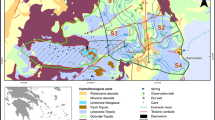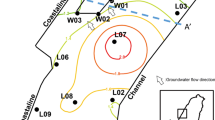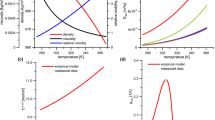Abstract
The influence of varying groundwater flow velocities on DNAPL infiltration and spreading behaviour was investigated by multiphase modelling using TMVOC and PetraSim. The multiphase models were calibrated by results of previously conducted laboratory experiments for the complete spatio-temporal range of the experiments. The small scale 2D scenario modelling was applied to qualify and quantify changes in position, architecture, geometry and dissolution of a TCE body in a fully saturated homogeneous sandy medium. The applied flow velocities ranging from 0.05 up to 40.00 m/day exhibited that the DNAPL TCE is affected even at the lowest flow velocity in its position, its size and its architecture. Additionally, several impermeable lenses with simple geometry were assumed in the model, to investigate the influence of stratified subsoil. In the experimental set-ups, the DNAPL body reacts more sensitive to the applied groundwater flow velocities than to the geometrical set-up of the scenarios. A possible consequence can be the transportation and displacement of a DNAPL pool due to natural or anthropogenic induced high groundwater flow velocities, as by Pump and Treat facilities, complicating site investigation process and planning of remediation activities.








Similar content being viewed by others
References
3M (2005) 3M Novec TM 7100—engineered fluid. Product Information. 3M Electronics, St. Paul
Bao WMJ, Vogler ET, Chrysikopoulos CV (2004) Nonaqueous liquid pool dissolution in three-dimensional heterogeneous subsurface formations. Environ Geol 43:10
Bradford SA, Rathfelder KM, Lang J, Abriola LM (2003) Entrapment and dissolution of DNAPLs in heterogeneous porous media. J Contam Hydrol 67:133–157
Broholm K, Feenstra S, Cherry JA (2005) Solvent release into a sandy aquifer. 2. Estimation of DNAPL mass based on a multiple-component dissolution model. Environ Sci Technol 39(1):317–324
Chang L-C, Chen H–H, Shan H-Y, Tsai J-P (2009) Effect of connectivity and wettability on the relative permeability of NAPLs. Environ Geol 56(7):1437–1447
Christ JA, Lemke LD, Abriola LM (2009) The influence of dimensionality on simulations of mass recovery from nonuniform dense non-aqueous phase liquid (DNAPL) source zones. Adv Water Resour 32(3):401–412
Dekker TJ, Abriola LM (2000) The influence of field-scale heterogeneity on the infiltration and entrapment of dense nonaqueous phase liquids in saturated formations. J Contam Hydrol 42(2–4):187–218
Erning K, Schäfer D, Dahmke A, Luciano A, Viotti P, Petrangeli Papini M (2010) Simulation of DNAPL distribution depending on groundwater flow velocities using TMVOC. In: Schirmer M, Hoehn E, Vogt T (eds) IAHS publication: groundwater quality management in a rapidly changing world. Proceedings of the 7th international groundwater quality conference held in Zurich, Switzerland, 13–18 June 2010, vol 342. Red Books. IAHS, Oxfordshire, pp 128–131
Fagerlund FF, Niemi A, Illangasekare TH (2006a) Modeling NAPL source zone formation in stochastically heterogeneous layered media—a comparison with experimental results. In: Paper presented at the TOUGH symposium 2006, Lawrence Berkeley National Laboratory, Berkeley, May 15–17
Fagerlund FF, Niemi A, Odén M (2006b) Comparison of relative permeability-fluid saturation-capillary pressure relations in the modelling of non-aqueous phase liquid infiltration in variably saturated, layered media. Adv Water Resour 29(11):1705–1730
Falta RW (2003) Simulation of subgridblock scale DNAPL pool dissolution using a dual domain approach. In: Paper presented at the TOUGH Symposium 2003, Lawrence Berkeley National Laboratory, Berkeley, May 12–14
Falta RW, Pruess K, Finsterle S, Battistelli A (1995) T2VOC user’s guide. U.S. Department of Energy, USA
Falta RW, Basu N, Rao PS (2005) Assessing impacts of partial mass depletion in DNAPL source zones: II. Coupling source strength functions to plume evolution. J Contam Hydrol 79(1–2):45–66
Fure AD, Jawitz JW, Annable MD (2006) DNAPL source depletion: linking architecture and flux response. J Contam Hydrol 85(3–4):118–140
Gerhard JI, Pang T, Kueper BH (2007) Time scales of DNAPL migration in sandy aquifers examined via numerical simulation. Ground Water 45(2):147–157
Golden Software Inc. (2007) Grapher 7.0. Golden
Greifenhagen G (2000) Untersuchungen zur Hydrogeologie des Stadtgebietes Darmstadt mit Hilfe eines Grundwasserinformationssystems—unter Verwendung von einer Datenbank, Datenmodellierung und ausgewählten statistischen Methoden. Diss. FB Material- und Geowissenschaften, Darmstadt
Herfort M, Ptak T (2002) Multitracer-Versuch im kontaminierten Grundwasser des Testfeldes Süd. Grundwasser 1:31–40
Herfort M, Ptak T, Hümmer O, Teutsch G, Dahmke A (1998) Testfeld Süd: Einrichtung der Testfeldinfrastruktur und Erkundung hydraulisch-hydrogeochemischer Parameter des Grundwasserleiters. Grundwasser 3(4):159–166
Hoehn E, Santschi PH (1987) Interpretation of tracer displacement during infiltration of river water to groundwater. Water Resour Res 23(4):340–366. doi:10.1029/WR023i004p0063
Hoehn E, Von Gunten HR (1989) Radon in groundwater: a tool to assess infiltration from surface waters to aquifers. Water Resour Res 25(8):1795–1803. doi:10.1029/WR025i008p01795
Illangasekare TH, Ramsey JL, Jensen KH, Butts MB (1995) Experimental study of movement and distribution of dense organic contaminants in heterogeneous aquifers. J Contam Hydrol 20(1–2):1–25
Illangasekare TH, Munakata Marr J, Siegrist RL, Soga K, Glover KC, Moreno-Barbero E, Heiderscheidt JL, Saenton S, Matthew M, Kaplan AR, Kim Y, Dai D, Page JWE (2006) Mass transfer from entrapped DNAPL sources undergoing remediation: characterization methods and prediction tools. Colorado School of Mines
Jawitz JW, Fure AD, Demmy GG, Berglund S, Rao PSC (2005) Groundwater contaminant flux reduction resulting from nonaqueous phase liquid mass reduction. Water Resour Res 41:15
Jellali S, Benremita H, Muntzer P, Razakarisoa O, Schäfer G (2003) A large-scale experiment on mass transfer of trichloroethylene from the unsaturated zone of a sandy aquifer to its interfaces. J Contam Hydrol 60(1–2):31–53
Kueper BH, Frind EO (1988) An overview of immiscible fingering in porous media. J Contam Hydrol 2(2):95–110
Lee KY, Lee J-Y, Mellett JJ (2004) Transport of dissolved methoxy-nonafluorobutane through a saturated column. Environ Geol 46(6):883–889
Li H, Chen J, Yang J (2011) Pore-scale removal mechanisms of residual light non-aqueous phase liquids in porous media. Environ Earth Sci. doi:10.1007/d12665-011-1050-8
Luciano A, Viotti P, Petrangeli Papini M (2010) Laboratory investigation of DNAPL migration in porous media. J Hazard Mater 176:1006–1017
Miles B, Maji R, Sudicky EA, Teutsch G, Peter A (2008) A pragmatic approach for estimation of source-zone emissions at LNAPL contaminated sites. J Contam Hydrol 96:83–96
Morrissey FA, Grismer ME (1999) Kinetics of volatile organic compound sorption/desorption on clay minerals. J Contam Hydrol 36(3–4):291–312
Page JWE, Soga K, Illangasekare T (2007) The significance of heterogeneity on mass flux from DNAPL source zones: an experimental investigation. J Contam Hydrol 94(3–4):215–234
Pankow JF, Cherry JA (1996) Dense chlorinated solvents and other DNAPLs in groundwater. Waterloo Press, Waterloo
Parker JC, Lenhard RJ (1987) A model for hysteretic constitutive relations governing multiphase flow in porous media. 1. Saturation-pressure relations. Water Resour Res 23(12):2187–2196
Parker JC, Park E (2004) Modeling field-scale dense nonaqueous phase liquid dissolution kinetics in heterogeneous aquifers. Water Resour Res 40:12
Pruess K, Battistelli A (2002) TMVOC, a numerical simulator for three-phase non-isothermal flows of multicomponent hydrocarbon mixtures in saturated-unsaturated heterogeneous media. Berkeley, California
Rivett MO, Feenstra S (2005) Dissolution of an emplaced source of DNAPL in a natural aquifer setting. Environ Sci Technol 39(2):447–455
Saenton S, Illangasekare TH, Soga K, Saba TA (2002) Effects of source zone heterogeneity on surfactant-enhanced NAPL dissolution and resulting remediation end-points. J Contam Hydrol 59(1–2):27–44
Sale TC, McWhorter DB (2001) Steady state mass transfer from single-component dense nonaqueous phase liquids in uniform flow fields. Water Resour Res 37:393–404
Soga K, Page JWE, Illangasekare TH (2004) A review of NAPL source zone remediation efficiency and the mass flux approach. J Hazard Mater 110(1–3):13–27
Stone HL (1970) Probability model for estimating three-phase relative permeability. Trans SPE AIME 249:214–218
Thunderhead Engineering (1999–2008) PetraSim—interactive model creation for advanced flow, transport and heat transfer models, 4.2 edn, Manhattan, USA
Von Gunten HR, Karametaxas G, Krähenbühl U, Kuslys M, Giovanoli R, Hoehn E, Keil R (1991) Seasonal biogeochemical cycles in riverborne groundwater. Geochim Cosmochim Acta 55(12):3597–3609
Zhu J, Sykes JF (2000) The influence of NAPL dissolution characteristics on field-scale contaminant transport in subsurface. J Contam Hydrol 41(1–2):133–154
Acknowledgments
We would like to thank our colleagues from La Sapienza University Rome (A. Luciano, P. Viotti and M. Petrangeli Papini), who conducted the laboratory experiments and generously provided the primary data set to calibrate the multiphase model. This research is financially supported by the European Union under the 7th European Framework, Project ModelPROBE (no 213161).
Author information
Authors and Affiliations
Corresponding author
Rights and permissions
About this article
Cite this article
Erning, K., Grandel, S., Dahmke, A. et al. Simulation of DNAPL infiltration and spreading behaviour in the saturated zone at varying flow velocities and alternating subsurface geometries. Environ Earth Sci 65, 1119–1131 (2012). https://doi.org/10.1007/s12665-011-1361-9
Received:
Accepted:
Published:
Issue Date:
DOI: https://doi.org/10.1007/s12665-011-1361-9




